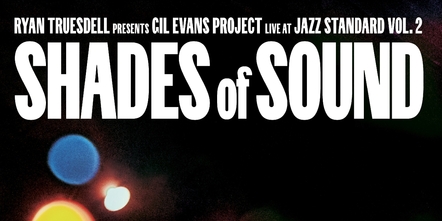New York, NY (Top40 Charts) Multi-Grammy Award-winning producer Ryan Truesdell reopens the Gil Evans Project vaults to release a new album of material recorded live at the beloved (now shuttered) New York City club, Jazz Standard. SHADES OF SOUND: Gil Evans Project Live at Jazz Standard, Vol. 2 will be released May 30, 2025 on Outside in Music.
Following in the footsteps of the band's two critically acclaimed and Grammy Award-nominated albums, Centennial (2012) and Lines of
Color (2015), SHADES OF SOUND continues to peel back the hidden layers of Gil Evans' musical legacy. This exhilarating new collection marks the first time the band appears on vinyl and features some of New York's finest musicians including Lewis Nash, Donny McCaslin, Steve Wilson, Ryan Keberle, Wendy Gilles, and the late Frank Kimbrough.
SHADES OF SOUND was recorded May 13-18, 2014 by Grammy Award-winning engineer
James Farber with the live engineering team of Tyler McDiarmid and Geoff Countryman during the band's annual week-long engagement at Jazz Standard. Picking up where Lines of
Color left off, SHADES OF SOUND consists of four never before recorded works ("Laughing at Life," "It's The Sentimental Thing To Do," "I Had Someone Else Before I Had You," and "Neetie's Blues"), and four of Evans' well-known arrangements from his seminal albums ("Spoonful," "The Ballad of the Sad Young Men," "Barbara Song," and "Buster's Last Stand"). Truesdell decided to record live to honor the essence of Evans' music that is transformed by the alchemy of live performance. "It allows Gil's colors and the overtones of the music to blend in the room in a way that you can't get from a close-mic studio recording," says Truesdell. "Live recording captures this intangible energy that's created when music is performed for an audience. It gives listeners a sense of the magic that happens when the notes are lifted off the page by these amazing musicians."
The eight selections that make up SHADES OF SOUND represent everything you hope for in a live recording: a beautiful sound, an engaged audience, and inspired performances of remarkable music. Of this collection, three of the charts were originally written during Evans' tenure with the
Claude Thornhill orchestra, including the energetic, bouncy Evans original "Buster's Last Stand," and two never-before-recorded vocal arrangements featuring the Gil Evans Project's vocalist, Wendy Gilles. "It's The Sentimental Thing To Do" creates an impressionistic cloud of Evans' signature orchestrational colors which belie his influences from classical composers like Debussy and Ravel, while slipping in subtle undercurrents of rhythmic bebop phrasing. Evans' bebop influences are more pronounced in "I Had Someone Else Before I Had You," emphasizing the stylistic angular phrasing while the tempo and feel give nods to the swing era as Gilles' tongue-in-cheek delivery is punctuated and supported by short, improvised solos by Steve Wilson and Marshall Gilkes.
Gilles' third feature, "Laughing At Life," was originally intended for vocalist Marcy Lutes' 1957 album Debut, but for unknown reasons it went unrecorded until this release. "I suspect the arrangement was too difficult," says Truesdell. "There are a few technically challenging passages that are nearly impossible to execute without extensive rehearsal. We've spent a lot of time with this chart and the reward was well worth the effort."
"Neetie's Blues" is a previously unknown Evans original, likely written in the late 1960s/early 1970s, which Truesdell discovered when doing research among Evans' manuscripts over fifteen years ago. The two-page score in sketch format was simply titled "Blues," but for this release, Evans' son Noah thought it deserved a more defined title and called it "Neetie's Blues" after a family nickname for his mother, Evans' wife, Anita. Presented here for the first time, tenor saxophonist Tom Christensen soars over Evans' gritty ensemble writing, driven by Lewis Nash's heavy, slightly dirty swing feel and urged on by Frank Kimbrough's deeply bluesy, conversational accompaniment.
One of Evans' most haunting and gorgeous arrangements, "The Ballad of the Sad Young Men," was first recorded on his 1959 album Great Jazz Standards. The Gil Evans Project's rendition begins with an improvised solo piano prelude by Frank Kimbrough which beautifully sets up trombonist Ryan Keberle's achingly melancholic rendering of the melody. "The process of revisiting this music has been bittersweet," says Truesdell. "It's hard to hear these recordings without picturing Frank wedged into a corner of the stage behind a grand piano, listening intently and savoring the sounds and colors coalescing in that singular moment. But ultimately, it's a gift to once again witness and preserve the memory of his immense talent, deep passion, wry humor, and adventurous spirit."
Rounding out SHADES OF SOUND are the Gil Evans Project's dynamic performances of "Spoonful" and "Barbara Song," which both first appeared on Evans' 1964 album The Individualism of Gil Evans. Both charts exemplify the more atmospheric, soloist-driven approach Evans was exploring in his writing at the time and have become crowd favorites over the 14 years of the band's live performances. "Barbara Song" in particular allows tenor saxophonist Donny McCaslin to stretch out and create his own narrative arc in the moment, with the conducted ensemble backgrounds generating a spontaneous dialogue between soloist and ensemble.
With the addition of SHADES OF SOUND to the Gil Evans Project's discography, Truesdell has created a historic and invaluable auditory triptych posthumously honoring one of the most significant compositional voices in jazz, and secured his reputation as one of the foremost Gil Evans scholars. By continuing to mine the depths of Evans' creative vision, and exciting audiences and listeners with virtuosic performances of his lost music, Truesdell is amplifying our understanding of Evans' place in our musical history, and bringing his genius from the past, into the present once again.
























